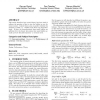29 search results - page 2 / 6 » Sizing Router Buffers for Large-Scale TCP IP Networks |
INFOCOM
2006
IEEE
13 years 10 months ago
2006
IEEE
— In this paper, we propose a simulation framework, TranSim, that reduces the rate at which packet-events are generated, in order to accelerate large-scale simulation of IP netwo...
INFOCOM
2003
IEEE
13 years 10 months ago
2003
IEEE
— The aim of this paper is to simulate the interaction of a large number of TCP controlled flows and UDP flows sharing many routers/links, from the knowledge of the network par...
CCR
2005
13 years 4 months ago
2005
This article describes how control theory has been used to address the question of how to size the buffers in core Internet routers. Control theory aims to predict whether the net...
CCR
2006
13 years 4 months ago
2006
In the past two years, several papers have proposed rules that suggest two to five orders of magnitude reduction in Internet core router buffers. Others present scenarios where bu...
SIGCOMM
2004
ACM
13 years 10 months ago
2004
ACM
All Internet routers contain buffers to hold packets during times of congestion. Today, the size of the buffers is determined by the dynamics of TCP’s congestion control algor...

